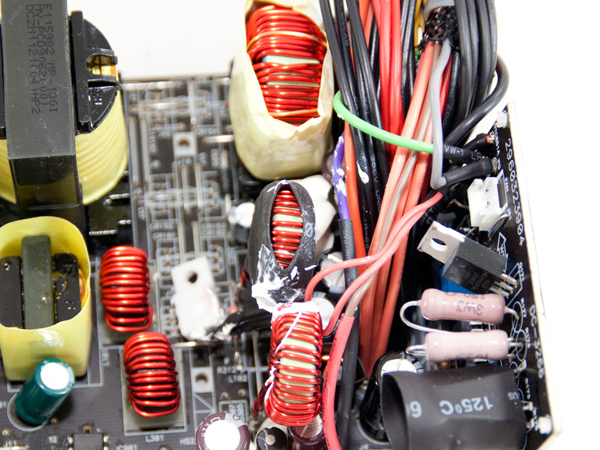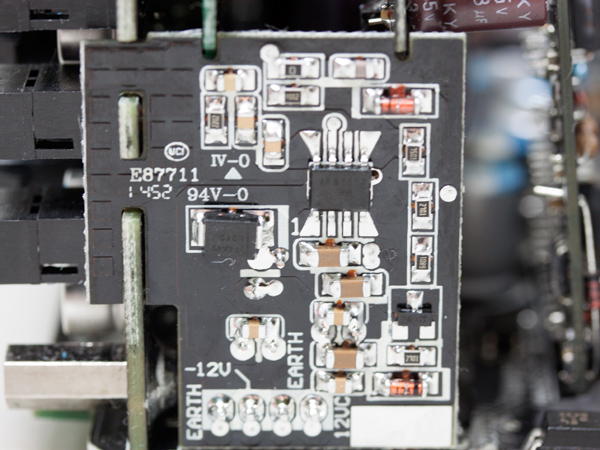PSUs 101: A Detailed Look Into Power Supplies
The objective of this article is to provide detailed information about the most crucial part of a personal computer (PC) system, its power supply unit. Follow us on this journey into PSU territory and we promise that you will gain valuable knowledge.
Output Rectifiers And Filters
The role of output rectifiers and filters is, as their names imply, to rectify and filter the high-frequency switching waveform created by the switchers (FETs) and fed through the secondary side of the main transformer(s). In this stage, we see two types of rectification designs: passive and synchronous.
In the passive design, Schottky barrier rectifiers (SBRs) are used, and in the synchronous design, FETs take the place of SBRs. In synchronous rectification, efficiency is increased, since we get rid of the forward voltage drops of SBRs.
To make this easier to follow, let's look at an example. A typical SBR has a 0.5V voltage drop, so if we want to conduct 40A, then we have 40A x 0.5V = 20W. If we use a FET instead of an SBR, and assume that the FET's RDS(on) is 3mΩ, then we have 40A x 40A x 0.003Ω = 4.8W. This results in 15.2W less power dissipation and a 24 percent increase in efficiency.
In addition to the passive and synchronous designs, sometimes a hybrid one, called semi-synchronous design, may be employed where FETs and SBRs are used to reduce cost and increase efficiency above the passive design's levels.
The generation of -12V is usually done with a conventional diode, since PSUs don't demand much power from this rail (below 1A, in most cases). However, in some high-end PSUs, there is a dedicated regulation circuit, even for this insignificant rail. For 5VSB, a completely independent circuit with a transformer is usually used, since 5VSB rails are working continuously even when the PSU is in standby mode. For the generation or filtering of the main outputs (+12V, 5V and 3.3V), there are three regulation types: group regulation, independent regulation and DC-DC conversion.


Group Regulation
Group regulation is usually used in low-capacity and budget PSUs. An easy way to identify a group regulation design is by checking the number of coils used in the secondary side. If you find only two, then group regulation is present. The bigger coil is used for 12V/5V, and the smaller one is used for 3.3V.
In this regulation type, +12V and 5V are generated together, and both of them feed their output voltage error to the regulator controller. This means that if the load is unbalanced between the rails, then the regulator controller will have a very hard time retaining a proper regulation. For example, if the load at +12V is high and the load at 5V is low, the voltage on the second rail will be raised, because the regulator controller tries to raise the +12V rail's voltage. But because the latter is tied to 5V, both of them are raised. This is why most group-regulated PSUs fail to keep their rails within +/-5 percent tolerance during cross-load tests.
Get Tom's Hardware's best news and in-depth reviews, straight to your inbox.
In group regulation, the 3.3V rail is usually regulated by a magnetic-amplifier post regulator from 5V or from 12V. Most group-regulated PSUs fail to meet Intel's Haswell-ready test, where the PSU must keep all of its rails within the ATX spec when the full load is applied on the minor rails (5V and 3.3V) and load on the +12V rail is at a minimum (0.1A).


Independent Regulation
Independent regulation is used in higher-capacity and performance PSUs, where cost reduction isn't the top priority. In this type of regulation, all main DC outputs are generated by independent circuits, so unbalanced loads do not cause voltage problems. The +12V rail is regulated by the main regulator controller and 5V/3.3V mag-amp post regulators.
You can easily identify a PSU that uses independent regulation by the number of toroidal coils in its secondary side. If you find three of them (one for each rail), then the PSU uses independent regulation, so it won't have any problems when handling unbalanced loads among the rails.
DC-DC Converters/Voltage Regulation Modules
In many PSUs nowadays, the minor rails are generated independently with the use of buck (or step-down) converters (DC-DC converters or voltage regulation modules). In these PSUs, the minor rails (5V and 3.3V) are generated through the +12V rail, and this provides a significant efficiency boost and good performance, even with unbalanced loads. In some high-end platforms, the DC-DC converters are installed on a modular board in order to minimize energy loss due to power transfer.
Before we move on to the next stage, we should stress that the toroidal chokes located after the rectifiers take part not only in the rectification, but also in the filtering process, since they are used for ripple, voltage and current reduction on the DC outputs. However, in PSUs that utilize LLC resonant converters, usually there are no toroidal chokes in the secondary side (for the +12V generation), and if there are any, they are used only for filtering purposes.
Current page: Output Rectifiers And Filters
Prev Page Main Switchers And Transformers Next Page Switching Controllers And Isolators
Aris Mpitziopoulos is a contributing editor at Tom's Hardware, covering PSUs.
-
Alexis Shaw In your list of top-tier capacitor manufacturers you missed out on some of the better american and european manufacturers, while these may not be used on many consumer-grade power supplies they are definitely top-tier and if you were to find them you would be happy. I suggest the addition of at least:Reply
Cornell Dubilier (USA)
Illinois Capacitor (Now owned my Cornell Dubilier)
Kemet Corporation (USA)
ELNA (Japan)
EPCOS (TDK company) (Germany)
Vishay (USA)
Würth Elektronik (Germany)
-
Aris_Mp Thank you very much for the list you provided. I am aware of almost all cap brands that you mentioned but unfortunately so far I found none of them inside a desktop/consumer grade PSU. I will think about it however (and also make a research on these cap brands), if I should include them as well inside my list.Reply
-
InvalidError Reply
There is a very high probability you have seen PSUs with several Kemet capacitors in them. You never noticed them simply because SMD capacitors are too small to carry logos, brand name or even value designations.16585466 said:Thank you very much for the list you provided. I am aware of almost all cap brands that you mentioned but unfortunately so far I found none of them inside a desktop/consumer grade PSU.
The other brands are mostly found in specialty applications such as lab instruments, industrial machines and high-end audio. -
Math Geek very interesting read. more in depth than i need to know yet for the most part understandable and with careful reading it did not leave me confused.Reply
nice article. -
TallestJon96 I only read 2/3 of it, but it's a good article.Reply
I basically have committed PC heresy with my cx600m. However I think that I'm in the clear with my 65w CPU and 145w CPU. I'd bet my total power draw is actually below 300w, the supposed highest efficiency point of a PSU.
As a gamer, not a professional, I think it is better to get low power parts, and get a higher rating than you need, rather than get high power parts and high quality PSUs.
Additionally, if you compare power consumption of a typical system from today to one from 5 years ago, power draw is considerably lower, with the exception of certain graphics cards. *cough* 390x *cough* -
powernod I decided to sign up at Tom's forum, and the only reason was to state how excellent is Aris's article!!!Reply
Thanks Aris for this very useful article on behalf of us all who want to learn the basic knowledge for PSUs.
Haven't finished it yet, but i'm very anxious for it !!! -
traumadisaster I'm glad there are people dedicated to this but I'm not. I can't even read all of the chapter titles in this article. I disagree with the importance you place on this and all of the references you made to this being crucial knowledge.Reply
PSU and MB are insignificant to me and I can blindly pick one by reviewing user comments from newegg in about 5 min, and it will last for years. For less than $100 each I'm set for nearly a decade.
CPU and gfx card now that affects fps and is over $1000, actually the most important part to me. -
Alexis Shaw Reply16589602 said:I'm glad there are people dedicated to this but I'm not. I can't even read all of the chapter titles in this article. I disagree with the importance you place on this and all of the references you made to this being crucial knowledge.
PSU and MB are insignificant to me and I can blindly pick one by reviewing user comments from newegg in about 5 min, and it will last for years. For less than $100 each I'm set for nearly a decade.
CPU and gfx card now that affects fps and is over $1000, actually the most important part to me.
I heartily dissagree, user are not the best way to judge reliability, and a bad powersupply is at fult most of the time there is a hardware issue. Further a power supply should last more than one system build, and in general I keep mine for a decade at a time at least. So an investment in a good power supply is not a waste, and a bad one will kill that precious $1000 GPU or CPU. The demo dart power supply on the motherboard is a similar story, however in general they are of higher quality than a cheap mains supply.
-
Alexis Shaw Reply16585679 said:
There is a very high probability you have seen PSUs with several Kemet capacitors in them. You never noticed them simply because SMD capacitors are too small to carry logos, brand name or even value designations.16585466 said:Thank you very much for the list you provided. I am aware of almost all cap brands that you mentioned but unfortunately so far I found none of them inside a desktop/consumer grade PSU.
The other brands are mostly found in specialty applications such as lab instruments, industrial machines and high-end audio.
As well as SMT ceramic capacitors, Kemet makes through hole aluminium electrolytic capacitors. These are of high quality, though not as well known as their SMT capacitors. They also make high quality polymer SMT capacitors that are used as bulk capacitors on the power distribution circuitry on laptops and other devices.

